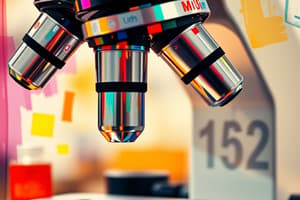Podcast
Questions and Answers
What is a compound light microscope?
What is a compound light microscope?
- Microscope that allows light to pass through a specimen and uses two lenses to form an image (correct)
- Microscope that only uses one lens
- Microscope used for viewing very small living organisms
- Microscope that uses electron beams
What is the function of the body tube in a microscope?
What is the function of the body tube in a microscope?
Passageway for light and maintains correct distance between lenses
What does the eyepiece contain?
What does the eyepiece contain?
Ocular lens
What is the purpose of the stage of the microscope?
What is the purpose of the stage of the microscope?
What does the low power objective provide?
What does the low power objective provide?
What is the coarse adjustment used for?
What is the coarse adjustment used for?
What is the highest magnification on a microscope called?
What is the highest magnification on a microscope called?
What does the fine adjustment allow for?
What does the fine adjustment allow for?
What is the purpose of stage clips?
What is the purpose of stage clips?
What does the nosepiece do?
What does the nosepiece do?
What does the diaphragm of the microscope regulate?
What does the diaphragm of the microscope regulate?
What connects the stage to the eyepiece in a microscope?
What connects the stage to the eyepiece in a microscope?
What is the base of the microscope?
What is the base of the microscope?
What is magnification in the context of a microscope?
What is magnification in the context of a microscope?
What is referred to as the image in the microscope?
What is referred to as the image in the microscope?
What is the field of view in a compound microscope?
What is the field of view in a compound microscope?
Flashcards are hidden until you start studying
Study Notes
Compound Light Microscope Overview
- A compound light microscope uses light to illuminate specimens and two lenses to magnify images.
Components of the Microscope
-
Body Tube: Serves as a passageway for light, ensuring the correct distance between the lenses.
-
Eyepiece: Contains the ocular lens and is where the viewer looks to observe the specimen.
-
Stage: The platform upon which specimens are placed for examination.
-
Stage Clips: Secure the slide in position on the stage.
-
Nosepiece: Holds and allows for the rotation of objective lenses for more versatile viewing.
Objective Lenses
-
Low Power Objective: Shortest objective lens providing initial magnification.
-
High Power Objective: Longest objective with the highest magnification capabilities.
Focusing Mechanisms
-
Coarse Adjustment: Used for the initial focusing of the microscope, suitable only with low power objectives.
-
Fine Adjustment: Enables detailed focusing, intended for use with high power objectives.
Light Management
- Diaphragm: Located between the stage and light source, it regulates light intensity passing through the specimen.
Structure
-
Arm: Connects the stage to the eyepiece, providing structural support.
-
Base: The bottom part of the microscope, ensuring stability during use.
Imaging and Viewing
-
Magnification: Defined as the increase in apparent size of an object, calculated as ocular lens power multiplied by objective lens power.
-
Field of View: The observable area of the specimen through the eyepiece; important for assessing specimen details.
Specimen Representation
- Image in the Microscope: The specimen being viewed and analyzed under the microscope.
Studying That Suits You
Use AI to generate personalized quizzes and flashcards to suit your learning preferences.




